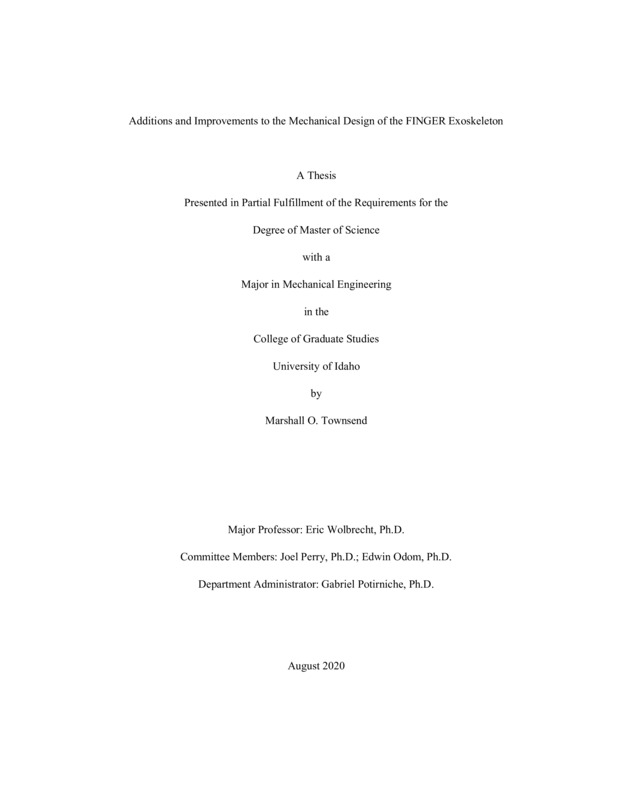Additions and Improvements to the Mechanical Design of the FINGER Exoskeleton
Townsend, Marshall. (2020-08). Additions and Improvements to the Mechanical Design of the FINGER Exoskeleton. Theses and Dissertations Collection, University of Idaho Library Digital Collections. https://www.lib.uidaho.edu/digital/etd/items/townsend_idaho_0089n_11915.html
- Title:
- Additions and Improvements to the Mechanical Design of the FINGER Exoskeleton
- Author:
- Townsend, Marshall
- Date:
- 2020-08
- Program:
- Mechanical Engineering
- Subject Category:
- Mechanical engineering
- Abstract:
-
Rehabilitation robots are important tools for post stroke movement training and efficacy quantification. The Finger INdividuating Grasp and Exercise Robot (FINGER) is a robotic exoskeleton designed to administer and study finger movement training. Developed nearly a decade ago and used for numerous investigative studies, the FINGER exoskeleton is currently in the process of being updated. This thesis covers design improvements to the FINGER 8-bar mechanisms, development of novel finger cuffs, and initial solid-model design prototyping of a spherical 5-bar mechanism for thumb training.
The 8-bar mechanisms that FINGER uses to actuate the index and middle fingers were redesigned with thicker links to increase rigidity and to reduce high stress concentrations. The joints of the mechanism were modified to use larger bearings with an extended inner race, allowing them to be easily spaced without the need for shims. The mechanism was also modified to extend an additional fifteen degrees to allow the user to fully open their index and middle fingers.
Feedback from patients and clinicians about the fit and function of FINGER has been used to redesign the finger cuffs to be more comfortable, and to be easier to don and doff. This was achieved by adding BOA® ratchet dials which use braided metal cables that size the cuffs; the cables loop over a hook on the opposite side. The cable is covered by a leather strap which increases comfort, keeps the cable properly aligned, and prevents direct contact between the cable and the skin.
Thumb trajectory information, recorded using a marker-based motion capture system, was used for the kinematic design of a spherical 5-bar mechanism. This mechanism will be actuated by the same linear actuators as FINGER, which are fixed to a platform on which FINGER is secured. A proposed design, including the location of these actuators, is presented. The thumb is connected to the mechanism through a cuff with a BOA® dial and a leather strap, similar to the finger cuffs. The thumb cuff rotates freely so the thumb can assume a comfortable orientation.
- Description:
- masters, M.S., Mechanical Engineering -- University of Idaho - College of Graduate Studies, 2020-08
- Major Professor:
- Wolbrecht, Eric
- Committee:
- Perry, Joel; Odom, Edwin
- Defense Date:
- 2020-08
- Identifier:
- Townsend_idaho_0089N_11915
- Type:
- Text
- Format Original:
- Format:
- application/pdf
- Rights:
- In Copyright - Educational Use Permitted. For more information, please contact University of Idaho Library Special Collections and Archives Department at libspec@uidaho.edu.
- Standardized Rights:
- http://rightsstatements.org/vocab/InC-EDU/1.0/

